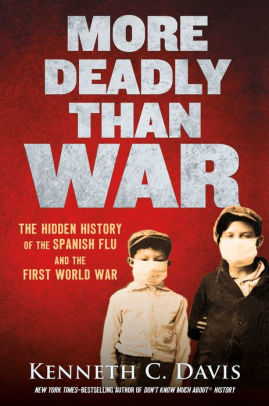I've been a middle school librarian for over 27 years and I believe that middle school kids deserve great books! Learn more at youngteenlit.com
Tuesday, May 26, 2020
More Deadly Than War: The Hidden History of the Spanish Flu and the First World War by Kenneth C. Davis
This book starts with a shocking story of Alaskan villages wiped out by a mysterious illness. Seventy-two out of 80 inhabitants of a village died in a 5-day period. It goes on to tell how the 1918 influenza epidemic, commonly known as the Spanish flu, actually emerged at an army camp in Kansas in March of 1918. From there, it spread to American military training camps and across the ocean to Europe, where it attacked soldiers on all sides of the Great War. One striking thing about this global pandemic is how little we know about it today, partly because governments purposely suppressed information about the disease during wartime and partly because traumatized people wanted to forget about it. Although it killed over 600,000 Americans, and millions worldwide, this global pandemic has largely been lost to history. This account deals largely with the disease and its connections to World War I. There is less coverage of how the disease affected women, children, civilians back at home, and people of color. From the vantage point of 2020, it would have been fascinating to read more about how communities handled school closures, commerce, public gatherings, and social distancing. Younger readers may get bogged down by war details in the middle, but the opening few chapters and concluding chapters are stunning. Now that we are in the midst of another disease outbreak, this very timely book will be of interest to young people and adults alike. With so much here that connects to the COVID pandemic, this is a must-have book for libraries everywhere.
Labels:
disease,
History,
Nonfiction,
pandemic,
War,
World War I
Subscribe to:
Post Comments (Atom)

No comments:
Post a Comment